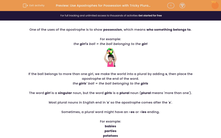One of the uses of the apostrophe is to show possession, which means who something belongs to.
For example:
the girl's ball = the ball belonging to the girl

If the ball belongs to more than one girl, we make the world into a plural by adding s, then place the apostrophe at the end of the word.
the girls' ball = the ball belonging to the girls
The word girl is a singular noun, but the word girls is a plural noun (plural means 'more than one').
Most plural nouns in English end in 's' so the apostrophe comes after the 's'.
Sometimes, a plural word might have an -es or -ies ending.
For example:
babies
parties
potatoes
wolves

When something 'belongs' to one of these words, we put the apostrophe at the end of the word, just as with boys' and girls'.
For example:
The wolf's prey = the prey of one wolf
The wolves' prey = the prey of several wolves
Let's practise using apostrophes to show possession with plural nouns.









